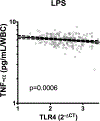Aging leads to dysfunctional innate immune responses to TLR2 and TLR4 agonists
- PMID: 30402800
- PMCID: PMC6504629
- DOI: 10.1007/s40520-018-1064-0
Aging leads to dysfunctional innate immune responses to TLR2 and TLR4 agonists
Abstract
Background: Sepsis is more common in the elderly. TNF⍺ is recognized as an important mediator in sepsis and Toll-like receptors (TLRs) play an important role in initiating signaling cascades to produce TNF⍺. Little is known about how innate immunity is altered in healthy human aging that predisposes to sepsis.
Aims and methods: We tested the hypothesis that aging dysregulates the innate immune response to TLR 2 and 4 ligands. We performed whole blood assays on 554 healthy subjects aged 40-80 years. TNFα production was measured at baseline and after stimulation with the TLR2 agonists: peptidoglycan, lipoteichoic acid, Pam3CysK, Zymosan A and the TLR4 agonist lipopolysaccharide (LPS). In a subset of subjects (n = 250), we measured Toll-like receptor (TLR) 2, 4 and MyD88 expression using real-time PCR.
Results and discussion: We measured a 2.5% increase per year in basal secretion of TNFα with aging (n = 554 p = 0.02). Likewise, TNFα secretion was increased with aging after stimulation with peptidoglycan (1.3% increase/year; p = 0.0005) and zymosan A (1.1% increase/year p = 0.03). We also examined the difference between baseline and stimulated TNFα for each individual. We found that the increase was driven by the elevated baseline levels. In fact, there was a diminished stimulated response to LPS (1.9% decrease/year; p = 0.05), lipoteichoic acid (2.1% decrease/year p = 0.03), and Pam3CysK (2.6% decrease/year p = 0.0007). There were no differences in TLR or MyD88 mRNA expression with aging, however, there was an inverse relationship between TLR expression and stimulated TNFα production.
Conclusions: With aging, circulating leukocytes produce high levels of TNFα at baseline and have inadequate responses to TLR2 and TLR4 agonists. These defects likely contribute to the increased susceptibility to sepsis in older adults.
Keywords: Aging; Immunosenescence; Inflammaging; Innate immunity; Sepsis; Shock; TLR signaling; TNFα.
Conflict of interest statement
CONFLICT OF INTEREST
On behalf of all authors, the corresponding authors states that there is no conflict of interest.
Figures


Similar articles
-
Effects of budesonide on toll-like receptor expression in alveolar macrophages from smokers with and without COPD.Int J Chron Obstruct Pulmon Dis. 2016 May 17;11:1035-43. doi: 10.2147/COPD.S102668. eCollection 2016. Int J Chron Obstruct Pulmon Dis. 2016. PMID: 27274225 Free PMC article.
-
Activation of Toll-like receptors by Burkholderia pseudomallei.BMC Immunol. 2008 Aug 8;9:46. doi: 10.1186/1471-2172-9-46. BMC Immunol. 2008. PMID: 18691413 Free PMC article.
-
Significance of toll-like receptors 2 and 4 mRNA expression in chronic hepatitis C virus infection.Egypt J Immunol. 2006;13(1):141-52. Egypt J Immunol. 2006. PMID: 17974158
-
Sepsis and high-density lipoproteins: Pathophysiology and potential new therapeutic targets.Biochim Biophys Acta Mol Basis Dis. 2025 Jun;1871(5):167761. doi: 10.1016/j.bbadis.2025.167761. Epub 2025 Mar 3. Biochim Biophys Acta Mol Basis Dis. 2025. PMID: 40044061 Review.
-
Early innate immune responses to bacterial LPS.Curr Opin Immunol. 2017 Feb;44:14-19. doi: 10.1016/j.coi.2016.10.005. Epub 2016 Nov 12. Curr Opin Immunol. 2017. PMID: 27842237 Free PMC article. Review.
Cited by
-
Factors Modulating COVID-19: A Mechanistic Understanding Based on the Adverse Outcome Pathway Framework.J Clin Med. 2022 Jul 31;11(15):4464. doi: 10.3390/jcm11154464. J Clin Med. 2022. PMID: 35956081 Free PMC article. Review.
-
Involvement of the visfatin/toll-like receptor 4 signaling axis in human dental pulp cell senescence: Protection via toll-like receptor 4 blockade.J Dent Sci. 2023 Jul;18(3):1177-1188. doi: 10.1016/j.jds.2022.10.008. Epub 2022 Oct 21. J Dent Sci. 2023. PMID: 37404665 Free PMC article.
-
Linking alcohol use to Alzheimer's disease: Interactions with aging and APOE along immune pathways.Med Res Arch. 2024 Aug;12(8):10.18103/mra.v12i8.5228. doi: 10.18103/mra.v12i8.5228. Epub 2024 Aug 31. Med Res Arch. 2024. PMID: 39544182 Free PMC article.
-
Focal Staphylococcus Aureus Septic Arthritis Elicits Age and TLR2-Dependent Periarticular Bone Loss.J Inflamm Res. 2024 Dec 31;17:11901-11913. doi: 10.2147/JIR.S479718. eCollection 2024. J Inflamm Res. 2024. PMID: 39758941 Free PMC article.
-
Correction of age-associated defects in dendritic cells enables CD4+ T cells to eradicate tumors.Cell. 2024 Jul 25;187(15):3888-3903.e18. doi: 10.1016/j.cell.2024.05.026. Epub 2024 Jun 12. Cell. 2024. PMID: 38870946 Free PMC article.
References
-
- Xu J, et al., Deaths: final data for 2014. 2016. - PubMed
-
- Martin GS, Mannino DM, and Moss M, The effect of age on the development and outcome of adult sepsis. Crit Care Med, 2006. 34(1): p. 15–21. - PubMed
-
- Pisani MA, Analytic reviews: considerations in caring for the critically ill older patient. Journal of intensive care medicine, 2009. 24(2): p. 83–95. - PubMed
-
- Dombrovskiy VY, et al., Rapid increase in hospitalization and mortality rates for severe sepsis in the United States: a trend analysis from 1993 to 2003. Crit Care Med, 2007. 35(5): p. 1244–50. - PubMed
-
- Grivennikov SI, et al., Distinct and nonredundant in vivo functions of TNF produced by t cells and macrophages/neutrophils: protective and deleterious effects. Immunity, 2005. 22(1): p. 93–104. - PubMed
MeSH terms
Substances
Grants and funding
- R01 AG053553/NIA NIH HHS/National Institute on Aging/United States
- R01 OH008539/NIOSH CDC HHS/National Institute for Occupational Safety and Health/United States
- R01 OH008539/OH/NIOSH CDC HHS/United States
- R01OH008539/NIOSH CDC HHS/National Institute for Occupational Safety and Health/United States
- I01 CX000434/CSRD VA/Clinical Science Research & Development/United States
LinkOut - more resources
Full Text Sources
Other Literature Sources
Medical

